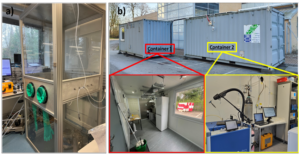Emissions and air quality impacts from use of aggressive surface cleaners indoors
Background
Emissions from building materials, furnishings, plants, pets and from occupant activities such as cooking and cleaning, all contribute to poor air quality indoors. Indoor air is currently a hot topic. Potential impacts on respiratory health are of great concern, given we spend over 90% of our time breathing indoor air. Cleaning products are a particularly important source of emissions. Product formulations are not routinely disclosed by manufacturers, but often contain complex mixtures of solvents, including harmful compounds, and aroma chemicals such as monoterpenes that are highly reactive indoors. One increasingly prevalent class of products are the aggressive kitchen or bathroom surface cleaners, marketed variously as “power”, “oxy”, “muscle” cleaners, that combine traditional solvent and fragrance components with active chemical ingredients.
Objectives
1) identify the primary gas-phase emissions from a range of cleaning products under controlled laboratory conditions;
2) use the wide range of air pollutant diagnostics in the Wolfson Atmospheric Chemistry Laboratories to measure emission rates for compounds of concern, i.e. those known to be directly harmful or to drive rapid indoor air chemistry;
3) scale-up experiments to explore the chemistry provoked by these emissions and understand impacts on indoor air quality via model simulations.

Experimental Approach
In this interdisciplinary project, you will apply a range of experimental, analytical and modelling techniques to improve our understanding of indoor air chemistry. Key techniques for the experimental measurements will be online selective ionisation flow-tube mass spectrometry (SIFT-MS) and gas-chromatography coupled to mass-spectrometry (GC-MS). Initial experiments will be conducted under controlled laboratory conditions, making use of a bespoke test chamber in the Wolfson Atmospheric Chemistry Laboratories (Fig. 1a). Subsequent, more realistic experiments will be conducted both at room-scale the highly instrumented DOMESTIC kitchen lab (Fig 1b) and at full building scale in the new INTERIORS test house facility on the York campus. These experiments generate significant amounts of data, so a willingness to learn professional data handling/analysis tools will be important.
Training
The Dillon and Carslaw research groups are key components of the indoor air team at York. Researchers from Wolfson Atmospheric Chemistry Laboratories and the Dept of Environment and Geography collaborate to research the impacts of occupant activities on indoor air chemistry, quality and health. We have regular meetings with external speakers from a range of built environment disciplines. We work with a range of external organisations, including brand leaders from the cleaning industry, UK consumer organisations and news media. High quality training will be provided to develop skills in the wide-ranging methods used. The Department of Chemistry at York is internationally recognised for supporting diverse researchers and providing high quality training.
References:
- L. Davies, C. O’Leary, b T. J. Dillon, D. R. Shaw, M. Shaw, A. Mehra, G. Phillips and N. Carslaw. A measurement and modelling investigation of the indoor air chemistry following cooking activities. Environ. Sci.: Processes Impacts, 2023, 25, 1532-1548. 10.1039/d3em00167a
- Harding-Smith, D. R. Shaw, M. Shaw, T. J. Dillon and N. Carslaw. Does green mean clean? Volatile organic emissions from regular versus green cleaning products. Environ. Sci. Processes Impacts, 26, 436, 2024, doi.org/10.1039/D3EM00439B
- Harding-Smith, H. L. Davies, C. O’Leary, R. Winkless, M. Shaw, T. J. Dillon, B. Jones and N. Carslaw. The impact of surfaces on indoor air chemistry following cooking and cleaning. Environ. Sci. Processes Impacts, 2024. doi.org/10.1039/D4EM00410H
